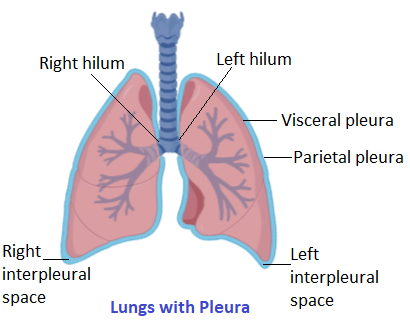
There is a membrane covering the lungs, called
A. Peritoneum
B. Pleura
C. Pericardium
D. Dura mater
Answer
471k+ views
Hint: Lungs are vital and sensitive organs of the human body involved in breathing. Exchange of gases takes place through the lungs. They are located on either side of the heart near the backbone. They are surrounded by a two-layered membrane that protects them.
Complete answer: The lungs are very sensitive organs that are surrounded by a protective layer that acts as a cushion for them. This is a two-layered membrane and reduces the friction that is developed between the lungs, chest cavity, and rib-cage. The membranous covering is called pleura.

The two layers of pleura are separated by a space that contains a viscous lubricant called pleural fluid. Pleura can be affected by many medical conditions. A collapsed lung, pleural effusions, and cancer can negatively affect the pleura. Each of the two lungs has its individual pleura. Pleura is a single membrane that folds on itself to make two membranes. One of the two layers is called visceral pleura. It is a thin and slippery membrane that surrounds the surface of the lungs. It dips into the area that separates different lobes of the lungs called the hilum. The other layer of pleura is called parietal pleura. It is the outer membrane and lines the inner chest wall along with the diaphragm. Both of these layers join at the hilum. The mesothelial cells in the intrapleural space are responsible for fluid secretion. This pleural fluid allows the two membranes to glide over each other when lungs deflate or inflate during exhalation and inhalation.
So, the right answer is option B.
Note: The pleura itself exhibits slightly adhesive qualities. This helps lungs draw outward during inhalation rather than slipping in the chest cavity. Also, the pleural fluid creates surface tension. This helps in the maintenance of the position of the lungs.
Complete answer: The lungs are very sensitive organs that are surrounded by a protective layer that acts as a cushion for them. This is a two-layered membrane and reduces the friction that is developed between the lungs, chest cavity, and rib-cage. The membranous covering is called pleura.

The two layers of pleura are separated by a space that contains a viscous lubricant called pleural fluid. Pleura can be affected by many medical conditions. A collapsed lung, pleural effusions, and cancer can negatively affect the pleura. Each of the two lungs has its individual pleura. Pleura is a single membrane that folds on itself to make two membranes. One of the two layers is called visceral pleura. It is a thin and slippery membrane that surrounds the surface of the lungs. It dips into the area that separates different lobes of the lungs called the hilum. The other layer of pleura is called parietal pleura. It is the outer membrane and lines the inner chest wall along with the diaphragm. Both of these layers join at the hilum. The mesothelial cells in the intrapleural space are responsible for fluid secretion. This pleural fluid allows the two membranes to glide over each other when lungs deflate or inflate during exhalation and inhalation.
So, the right answer is option B.
Note: The pleura itself exhibits slightly adhesive qualities. This helps lungs draw outward during inhalation rather than slipping in the chest cavity. Also, the pleural fluid creates surface tension. This helps in the maintenance of the position of the lungs.
Recently Updated Pages
Master Class 11 Economics: Engaging Questions & Answers for Success

Master Class 11 Business Studies: Engaging Questions & Answers for Success

Master Class 11 Accountancy: Engaging Questions & Answers for Success

Master Class 11 English: Engaging Questions & Answers for Success

Master Class 11 Computer Science: Engaging Questions & Answers for Success

Master Class 11 Maths: Engaging Questions & Answers for Success

Trending doubts
State and prove Bernoullis theorem class 11 physics CBSE

1 ton equals to A 100 kg B 1000 kg C 10 kg D 10000 class 11 physics CBSE

State the laws of reflection of light

One Metric ton is equal to kg A 10000 B 1000 C 100 class 11 physics CBSE

Difference Between Prokaryotic Cells and Eukaryotic Cells

1 Quintal is equal to a 110 kg b 10 kg c 100kg d 1000 class 11 physics CBSE




